Features
Sri Lanka’s ancient hydraulic civilisation and birth of Sinhala Buddhist nationalism

by Satyajith Andradi
Sri Lanka continues to be in the grips of many high profile crises of recent origin such as the COVID–19 pandemic, chronic difficulties in servicing foreign debts, shortages of essential items such as food and fuel, skyrocketing cost of living, and crop failures due to the ban of chemical fertilisers, to name a few . However, the national question, which has tormented the country for decades, continues to be one of her biggest problems, if not the greatest.
Sinhala Buddhist nationalism features prominently in any discourse on Sri Lanka’s national question. Its detractors often derogatorily call it by terms such as Sinhala Buddhist imperialism, Sinhala Buddhist chauvinism, and Sinhala Buddhist racism, whilst its protagonists call it Sinhala Buddhist patriotism or simply patriotism. Meanwhile, somewhat esoteric and ephemeral terms such as Sinhala Buddhist majoritarianism, kinguistic nationalism, and ethnocracy are used for it in learned discourse. Further, Sinhala Buddhist nationalism is very often discussed with reference to personages of Sri Lanka’s ancient history such as Dutugemunu and Elara. Hence, it is useful to trace the genesis and early phases of development of Sinhala Buddhist nationalism during Sri Lanka’s ancient past, in order to enhance our understanding of the subject.
Sri Lanka’s ancient agrarian revolution powered by irrigation engineering
As in our own age, in the distant past too, various races migrated from one land to another for various reasons such as the search for greener pastures and the forced eviction by intruding tribes. From about the sixth century BC, Sri Lanka too, which until then was thinly populated by primitive hunter gatherers, experienced an influx of migrants from overseas. Some of them, who had a knack for agriculture, settled in the arid north central plains of the island, which were covered with wooded forests and shrub jungles, as those one could still see in places such as Wilpattu. As direct rain water was often inadequate and undependable for growing paddy, these pioneer settlers cultivated the art of conserving water by building small artificial reservoirs called tanks, and convert the hostile arid terrain into paddy fields with the water thus conserved. Thereby they were able to establish a firm foothold in pre-historic Sri Lanka. These rough, tough, and enterprising pioneer settlers came to be known as ‘Sihala’ or Sinhalese, whose founding fathers were, according to legends, Vijaya and his band of seven hundred followers, who came to Sri Lanka from northern India. Other migrant tribes, either perished in this hostile physical environment, like the traders devoured by Kuveni, or got suppressed and assimilated by the dominant Sinhalese. This was a social process, which had some affinity to the process of natural selection in the biological world – a case of social Darwinism, so to speak. The Sinhalese went on to build progressively bigger tanks, weirs, canals, and complex irrigation systems connecting all such innovative creations with rivers which flowed from the distant wet mountains. As a result, the erstwhile wild and hostile terrain of Sri Lanka’s north central plains were converted into a vast blue and green tapestry of thousands of artificial lakes and lush paddy fields studded with dagobas of immaculate white. The formidable physical challenges posed by the nature were surmounted with an audacious human response. This monumental transformation, which took place more than thousand years ago, inspired many people of modern times. A notable person amongst them was the British planter, archaeologist, and author John Still ( 1880 – 1941 ) of Jungle Tide fame, who in turn drew the insightful attention of Arnold Toynbee, the eminent scholar of comparative history and civilizations ( Arnold J Toynbee; A study of history ; abridgement by D C Somervell ). The agrarian revolution powered by advanced irrigation systems was the bedrock, the backbone, and the material basis of the fully-fledged hydraulic civilization of ancient Sri Lanka. The elaborate social, political, cultural and religious institutions of that civilisation constituted, as Marx would say, its superstructure.
The birth of the ancient agrarian revolution based on irrigation engineering pre-dates the arrival of Buddhism in the island in the third century BC. The medium sized tank ‘Abhaya Wewa’, which is also known as Basawak Kulama, in Anuradhapura, built in the fourth century BC by king Pandukabhaya, proves the point. The next important tank, Tissa Wewa, was built in Anuradhapura during the reign of Devanampiyatissa ( 250 BC – 210 BC ). Irrigation engineering witnessed a quantum leap during the reign of the great Vasabha ( 67 AD – 111 AD ). During his reign, in addition to many large tanks, the Elahera canal was built. This canal diverted the waters of the Ambanganga, a tributary of the Mahaweli river originating from the Matale hills, to the tanks in the arid north central plains. The next great period of tank building was the reign of Mahasena ( 274 AD – 301 AD ), during which many tanks including the giant Minneriya Wewa was constructed. Mahasena’s achievements were equaled or surpassed during the reign of Dhatusena ( 455 AD – 473 AD ), during which huge tanks such as the Kalawewa and the Yoda Wewa were constructed, damming the Kala Oya and the Malwathu Oya respectively. However, the greatest irrigation engineering feat during the reign of Dhatusena was the construction of the Yoda Ela, also known as Jayaganga, a fifty four mile long canal which carried water from the Kalawewa to the Tissawewa in Anuradhapura. Further significant additions to the irrigation infrastructure were made during the reigns of Moggallana II ( 531 AD – 551 AD ) and Aggabodhi II ( AD 604 – AD 614 ). The former constructed the huge Nachchaduwa Wewa near Anuradhapura, augmented the Nuwara Wewa in Anuradhapura ( History of Ceylon, University of Ceylon: editor; S. Paranavitana ) and built the Padaviya tank by damming the Ma Oya (K M De Silva; A History of Sri Lanka ), whist the latter constructed the Kantale, Giritale, and Kaudulla tanks. Thereafter, the expansion of the irrigation systems seems to have subsided for several centuries till the time of Parakramabahu the Great ( 1153 – 1186 ). This king is considered to be the greatest tank builder of Sri Lanka (ibid ). The massive Parakrama Samudraya in Polonnaruwa, which was created by combining three tanks including the Topawewa, is undoubtedly his finest achievement in the field of tank building. It has to be been noted no other king after him built major tanks.
The ancient agrarian revolution powered by irrigation engineering had many important economic, social, political, religious, and cultural implications and outcome. On the economic sphere, it phenomenally increased the extent of arable land by making it possible to bring vast swathes of erstwhile arid forest land under the plough through irrigation. Further, it would have, most probably, facilitated a significant migration from small scale peasant subsistence farming to more productive large scale farming. Anyway, the obvious economic outcome of the ancient agrarian revolution was the generation of ever increasing agricultural surpluses over and about what was needed to feed the peasants and other agricultural labourers. These massive economic surpluses enabled the kings and their ruling elites to invest enormous resources in the expansion of the irrigation infrastructure, in maintaining the irrigation technocracy and the royal bureaucracy, in building impressive Buddhist monuments such as the great stupas, in patronizing outstanding Buddhist scholarship of international repute, and in constructing awe inspiring secular monuments such as Kasyapa’s Sigiriya rock fortress and royal palace.
On the social and political spheres, the elaborate irrigation systems stretching across vast swathes of farmlands, inexorably led to centralized control of agriculture through irrigation management. The technocrat who controlled the spills and the sluices of the tanks and weirs came to dominate the peasant who ploughed the fields, sowed the seeds, and harvested the crops. This entailed the ascendency of the state bureaucracy including the irrigation engineering technocracy, which in turn called for a unified and highly centralized state.
Pandukabhaya and birth of Sinhala state
It was mentioned earlier that the first significant tank was built by Pandukabhaya in the fourth century BC. It is interesting to note that he was also the first ruler of the Anuradhapura kingdom. Prior to him, the main Sinhala presence in Sri Lanka constituted a conglomerate of Sinhala settlements situated between the Kala Oya and the Malvattu Oya, loosely connected by tribal and family ties. It is evident that Pandukabhaya forcefully subjugated these semi-autonomous settlements and united them under his leadership. Thus the first Sinhala state was born. No doubt, this was in response to a historical necessity of the agrarian revolution, which called for an efficient centralized state. Certainly, this nascent state had nothing to do with Sinhala Buddhist nationalism or patriotism. In the first place, Buddhism was yet to be introduced to Sri Lanka. Further, the Sinhala state was yet to perceive a real threat from non – Sinhalese. It was young, vibrant and self- confident. It was, in modern parlance, an absolute monarchy.
Devamanpiyatissa and the birth of the Sinhala- Buddhist state
Buddhism was introduced to Sri Lanka by the great Mauryan emperor Asoka during the reign of Devamanpiyatissa ( 250 – 210 ) at a time when the ancient agrarian revolution was in full swing. As already mentioned, it was during this period that the Tissa Wewa was built. The peaceful conversion of the country to Buddhism received unreserved royal patronage. The nascent Sinhala state became a Sinhala Buddhist state. Numerous lands and viharas were gifted to the Maha Sanga. These included the Thuparama dagoba, and the spacious Mahamegha park in Anuradhapura, in which the sacred Bodhi tree Sri Maha Bodhi was planted. This signaled the establishment of the Mahaviharaya, the centre of Theravada Buddhist Church in Sri Lanka. No doubt, the doctrine of the Buddha, which laid down a well –structured spiritual path to freedom from existential suffering through the taming of the senses, struck a chord with the well-structured thinking of the Sinhalese irrigation engineers, which provided a path to freedom from material want by taming wild and hostile nature, with technological innovations.
Like Pandukabhaya’s Sinhala state, the nascent Sinhala Buddhist state during Devanampiyatissa’s had nothing to do with Sinhala Buddhist nationalism or patriotism. It did not perceive a real threat from non – Sinhalese or non-Buddhists. Like Pandukabhaya’s state, it was young, vibrant and self- confident.
The Sinhala Buddhist state under siege
Devanampiyatissa’s Sinhala Buddhist kingdom was in state of blissful harmony, arguably unparalled in Sri Lanka’s long history. However, this state of affairs was to be dramatically disrupted after a short period of time due to game-changing external and internal interventions. The major external challenge came from Tamil adventurers from south India bent on plundering the growing wealth of Sri Lanka’s hydraulic civilization. The main internal challenge came from the growing Mahayana tendencies amongst sections Sri Lanka’s Maha Sangha, which had traditionally been the custodian and standard bearer of Theravada Buddhism in Sri Lanka and abroad. Sinhala Buddhist Nationalism was born as a response to these challenges from within and without.
The first major challenge to the young Sinhala Buddhist state emerged thirty years after the death of Devanampiyatissa. Sena and Guttika, two Tamil brothers engaged in horse trading, captured the Anuradhapura kingdom and reigned for twenty two years. A few years after the Sinhalese regained the kingdom, the second successful invasion from South India was launched. This was led by the Chola prince Elara, who reigned in Anuradhapura for forty four years. The Sinhalese under Dutugemunu vanquished Elara and regained the kingdom. Dutugemunu’s reign ( 161 BC – 137 BC ) was a watershed in the Sri Lanka’s history. The island, which hitherto consisted of several kingdoms, was unified under his leadership. The Sinhala Buddhist state became, in present day parlance, a unitary state. However, less than four decades after Dutugemunu’s death, Anuradhapura was captured and occupied again by south Indian Tamils from 103 BC to 89 BC. They were expelled by Vattagamini ( Valagamba ) , who reigned from 89 BC to 77 BC. Thereafter, for more than five hundred years, Sri Lanka was free from foreign occupation. It was during this period that her ancient irrigation witnessed its first great flowering. However, it was during this period that the serious internal threats to the Sinhala Buddhist state emerged. They came in the form of Mahayana challenges to the uncontested supremacy of the Mahavihara led Theravada Buddhist Church, which was a main pillar of the Sinhala Buddhist state. The initial threat came in the first century BC with the establishment of the rival Abhayagiri monastery by Valagamba, which harboured dissenters. The immediate response of the Theravada Buddhist Church to this was the writing down of the Tripitaka at Aluvihara during that king’s reign. The next threat, which was of a much greater magnitude, was the intrusion of Mahayana thinking in the form of Vaitulyavada in the third century AD, during the reign of Mahasena ( 274 AD – 301 AD ), with the fanatical support of that monarch. This was somewhat contemporaneous with the rise of Mahayana in south India under the guidance of great masters such as Nagarjuna. Anyway, the Theravada Buddhist Church eventually prevailed by winning back the king to its side with great difficulty.
The long peace of half a millennium, which commenced with the reign of Valagamba, ended with the invasion from south India in 429 AD. This resulted in the reign of six Tamils kings in Anuradhapura for twenty seven years, until Dhatusena liberated the country from the foreign yoke. Thereafter, the country did not experience invasions from abroad for about four centuries. Ancient Sri Lankan irrigation witnessed its second great flowering. However, during ninth and tenth centuries, Sri Lanka got caught up in the geo-political rivalries amongst south Indian Tamil kingdoms of Pallavas, Pandyas and Cholas. At that time the Hindu Tamil civilization of south India was in its ascendency, whilst the aging Sinhala Buddhist civilization was in a state of stagnation, if not decay. The end result was the conquest of Anuradhapura and the north central plains of Sri Lanka by the Cholas in the closing decade of the tenth century. This dealt a crippling blow to Sri Lanka’s ancient hydraulic civilization. The Sinhalese were, under Vijayabahu I, able to expel the Cholas from the Island in 1070, and under Parakramabahu the Great, revive the ancient hydraulic civilization. Sri Lanka’s ancient irrigation witnessed its third and last flowering. However, the revival was short lived. The invasion by the marauding Kerala army of Magha of Kalinga in 1215 dealt the death blow to the ancient hydraulic civilization. The Sinhalese, who had populated the north central plains since sixth century BC, migrated en masse to the south west and the central hills. The irrigation works were abandoned and went into disrepair. The hostile arid jungles, which were banished by Sinhalese pioneers, returned to the north central plains with a vengeance. The ancient hydraulic civilization of the Sinhalese, which had flourished for more than one thousand five hundred years, came to an end.
The ancient hydraulic civilization and Sinhala Buddhist Nationalism
Sinhala Buddhist Nationalism, like many other –isms, constitute an ideology; an outlook. As already mentioned, it was born as a response to the external and internal challenges to the ancient Sinhala Buddhist state, which was an integrate part of the ancient hydraulic civilization. But, how do we conceptualise this ideology of Sri Lanka’s distant past? Fortunately, the ancient chronicles – Dipavamsa, Mahavamsa, and Chulavamsa, and the last two chapters of the Pujavaliya, come to our assistance. However, it should be cautioned that the ideologies contained in these ancient documents represent , more likely, the views held by their respective authors and their contemporary societies than by the personages of their narratives.
It seems that the internal threat to the Theravada Buddhism by Mahasena’s aggressive promotion of Vaitulyavada prompted the writing of the two oldest exiting chronicles of Sri Lanka – the Dipavamsa, written in the fourth century AD, and the Mahavamsa, composed in the sixth century AD. The fact that the narratives of both works end with the death of Mahasena points in that direction. Anyway, both emphasize that the island was freed from the Yakkas by the Buddha to make way for the Sinhalese settlers and the establishment of the Buddhist doctrine. This amounts to an imprimatur for Sinhala Buddhist exclusivity in Sri Lanka, which goes back, at least, as far as the fourth and sixth centuries. However, the treatment of the Sinhala king Dutugemunu and the Tamil king Elara by the two authors differ significantly. For instance, whilst the Dipavamsa devotes a mere twelve verses to Dutugemunu, the Mahavansa devotes eleven out of its thirty two chapters to him. Clearly, Dutugemunu is the favourite king of the author of the Mahavamsa. Further, whilst both chronicles admire Elara as an incomparably just king, the Dipavamsa, unlike the Mahavamsa, takes note of his outstanding spiritual qualities. More strikingly, the Mahavamsa, in chapter twenty five seeks to lend a Buddhist imprimatur to Dutugemunu’s war with Elara. This is certainly inconsistent with the letter and spirit of the Metta Sutta, as much as the crusades of medieval Christendom authorized by the papacy was inconsistent with the letter and spirit of Jesus’ utterance ” Put your sword in its place, for all who take the sword will perish by the sword” ( Matthew 26; 52 ). In fact, the Mahavamsa’s stance on the Dutugemunu- Elara war is reminiscent of the ideas on ‘just war’ advocated by St. Augustine and the Bhagavad Gita. Most probably, the south Indian invasions of the fifth century prompted the sixth century author of Mahavamsa to take a more militant Sinhala Buddhist stance than the fourth century author of the Dipavamsa.
The first part of the Chulavamsa, which was most probably composed in the early part of the thirteenth century, provides useful information about the period from the death of Mahasena to the end of the ancient hydraulic civilization. The last two chapters ( chapters 33 and 34 ) of the Pujavaliya briefly covers this period in addition to history up to the death of Mahasena. The Pujavaliya was composed in the mid thirteenth century, shortly after the collapse of the hydraulic civilization. Whilst the three chronicles were composed in Pali, the Pujavaliya was written in Sinhala.
The Chulavamsa and the Pujavaliya, in comparison with the Dipavamsa and the Mahavamsa, take a more hostile approach towards non – Sinhala Buddhist actors. For instance, unlike the Dipavamsa and the Mahavamsa, the Pujavaliya perceives Elara merely as a malevolent personage bent on destroying the Buddhist Church. The more virulent Tamil invasions from the ninth century onwards, would have contributed towards this more aggressive Sinhala Buddhist nationalism.
We have seen how the dynamics of the ancient hydraulic civilization gave birth Sinhala Buddhist Nationalism. The hydraulic civilization itself perished as a result of the devastating invasion of Magha of Kalinga. However, Sinhala Buddhist Nationalism did not perish with that civilization. On the contrary, it has continued to live as a potent ideology of Sri Lanka, right up to the present day.
Features
Emotions, learning, and democracy: Reviving the spirit of education
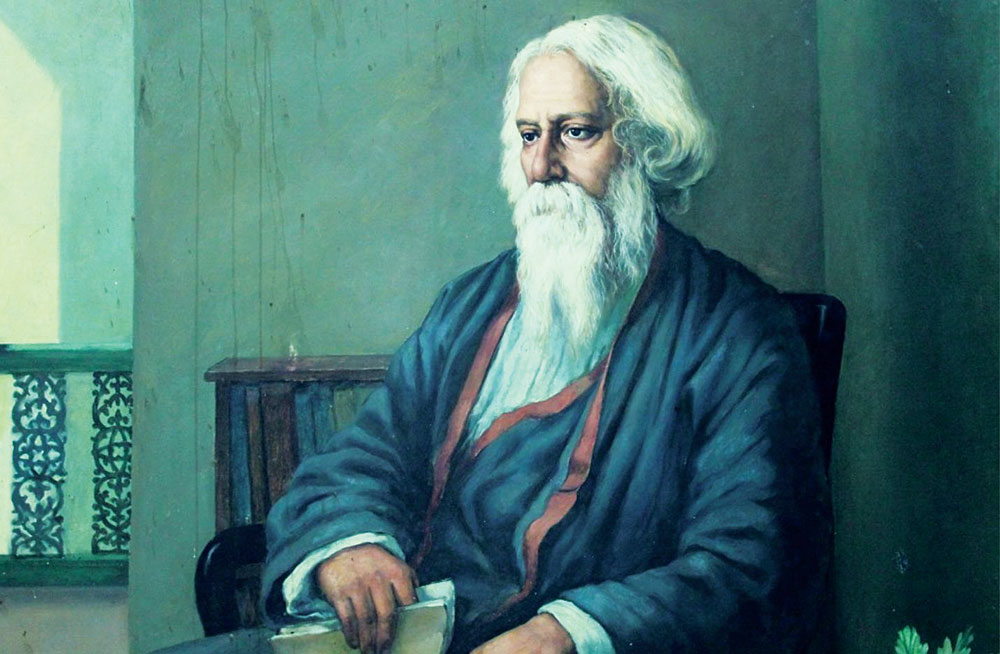
When a father becomes a gambler and his obligation to his family takes the secondary place in his mind, he is no longer a man, but an automaton led by the power of greed.
(Tagore, Nationalism, 2018)
(Excerpts of the keynote address at Annual Sessions at the Faculty of Education, The Open University of Sri Lanka––Empowering Minds: Education for New Era.)
As I am coming from the Humanities and Social Sciences and Performance Studies disciplines, I have a close affinity with education and education philosophy. I have also been engaged in the current debate on higher education, writing and presenting my ideas with the academia and the public domains. I have been motivated by the like-minded scholars (Senanayake, 2021; Amarakeerthi, 2013; Uyangoda, 2017 & 2023; Rambukwella, 2024; Jayasinghe & Fernando 2023; & Jayasinghe 2024) who have been continually discussing problems related to our education and the role of humanities and aesthetics within this sphere. Some of the recurrent themes I have raised in these writings are burning issues in our current education scenario.
Among them, the indoctrination, decline of the arts and aesthetic education in our education sector, and the importance of creative arts in human development were prominent. Hence, in today’s speech, I will continue this discussion and try to broaden the scope of it. The theme of today’s speech can be categorized in three areas of studies: emotions, education, and democracy. What I am going to present today is the role of emotion in education and how this new paradigm of education could lead to the democratic establishments in society. In this speech, I try to build a connection between these key areas of arts and aesthetic education, its vital ingredient of empathy, and how this empathic education supports democracy in the society. This argument will be further elaborated in the course of my talk.
We, as a nation, are on the verge of a transition. This transition has been gradually taking place in our society through the influences of neo liberal economic and political changes happening throughout the region. The glory of our free education system and the heritage we envisioned have also been challenged by the new developments of private educational institutions. These new trends have distorted the true meanings while diminishing the philosophical and moral values of education.
It is the skill acquisition that has come to the fore of the educational discourse. Skills that can be used in the social milieu, and can support the economic growth of the country have been commissioned for our curricula. This mantra has been circulated and supported by the governments which ruled this country for decades. We, as academics, have also adopted strategies to cater these policies to indoctrinate our children to become future entrepreneurs. All the philosophical and moral values of education have been reduced to produce mere labourers. Education is interpreted as a commodity, which is being sold in the market based on supply and demand. We are advised that if we cannot compete in the market, our survival is at stake.
Now, who are we? And, where are we? Where is our society heading? These simple but vital questions are important for us to rethink how we educate our children and what we gain out of it. What kind of society we have created today, as a whole after implementing those educational policies imposed by the authorities? Over the past few years, the world has gone through a myriad obstacles and difficulties facing a worldwide pandemic and devastating wars. After many centuries, we faced the Covid-19 pandemic which challenged us on how we live as a community. Over two years, we were locked down and were isolated from the world. We were locked down in our own houses and the social distancing was imposed reframing ourselves to be connected with each other.
Pandemic, Aragalaya and emotions
Pandemic introduced different ways of learning and teaching in our education sector. The traditional ways of teaching and learning were replaced by the online modes of learning. We started conducting seminars and lectures through online zoom technology and other modes to connect with our students. Students, somehow or other, connected with us through their mobile phones and other devices. The conception behind all these technological advancements implied that the education can be successfully delivered via online mode, and the cost can also be reduced drastically allowing the government to reduce the cost of education and infrastructure.
However, the vital concepts in the educational business, such as corporeality, subjectivity, intersubjectivity, temporality, and spatiality have been redefined and challenged. The learning and teaching were redefined in the virtual reality, reducing the values of interpersonal and corporeal connections between learners. We tend to believe that it is not important for the learner to be present in front of other learners but is enough for her or his virtual avatar to be present.
Soon after the taming of the pandemic situation, our society was shattered with the economic bankruptcy and social upheavals. The financial hardship experienced by the people of the country, resulted in demand for basic needs, cooking gas, petrol, and other important rations. Vigil and silent protests, followed by the mass movements and occupation, ignited the country’s largest non-party people’s struggle, Aragalaya.
Youth of the country encamped the Galle Face Green, and established alternative communal spaces. Cinema, school, community kitchen and even an alternative people’s university were established. Within a few days, many GotaGoGama encampments were established in major cities of the country demanding the President and the Parliament to resign. The new people’s democracy was established by people, for people. This mass movement not only showed us new ways of governing the country but also new ways of living as a community. Human connection and communal living were established until the military actions uprooted the GotaGoGama encampment.
You must be wondering why I am trying to recall this unpleasant past of our social memory. Why is it important for us to go back and see how we passed this phase of time and have come to this point today? As my key ideas are related to emotional education, empathy, arts, and democracy, it is important for us to revisit such a brutal past and learn lessons from it. The pandemic situation taught us how it is important for us, as human beings, to be connected and live with each other as a society.
The pandemic taught us the importance of revisiting communal life, which has sustained and enriched our lives for centuries. Aragalaya further emphasised the importance of communal struggle and co-living in order for us to establish a democratic society. Democracy cannot be sustained without human engagement. It is not something that the ruling government or an alien authority donates to us. It is something that is generated through human connections and collective will. If we clearly scrutinise those two phenomena we experienced in the recent past, it is evident that in the first phenomenon, the pandemic challenged our emotional engagement with others. In the second phenomenon, Aragalaya, we witnessed how important emotions are to reconnect with people and demand for democracy.
Anxiety of our time
Today, as educators, we are on the verge of resolving complex issues related to education. Information technology and AI have invaded the traditional teaching and leaning approaches. The role of the teacher is being challenged and also being shifted by artificial intelligence. The question arises, whether we have a key role to play in the lecture theatre or in the classroom when AI invades our positions. With technological advancement and artificial intelligence, our role as teachers and also what we teach are being challenged. Now, the question is what educational philosophy or theory is suitable for us to guide our next generation of learners’ what methods are appropriate for this new generation to learn and become valuable citizens for the country.
The argument that I want to bring forward is that in our education, we lost the key ingredient, which is the affective development in learning. In other words, we have not focused on how our learners should be equipped with emotional educational principles. Affective components of our education were marginalised or forgotten in favour of promoting skill development or manual learning. One of the reasons behind this lack is the way we conceptualised our educational policies, defining education in dichotomous ways.
For instance, as philosopher john Dewey says, ‘theory and practice, individual and group, public and private, method and subject matter, mind and behaviour, means and ends, and culture and vocation’ (Palmer et al., 2002, p. 197) are the ways that we defined our educational principles. Dewey’s educational philosophy is based on the key principle that the children should learn in the classroom where they learn the society through ‘miniature community and or embryonic society’ (Palmer et al., 2002, p. 196). It is vital for the students to learn this communal living, because in the larger canvas, they learn to live in the democratic society as elders. Communal empathy is thus a vital component in developing a healthy, democratic and caring society where each person has a place and respect.
Today, we focus on education, but the truth is we are living in a paradoxical era. Bruzzone (2024) argues that with this pandemic situation, the ongoing conflict between developed nations, and also the advancement of television and online technology, our young generation is in a conundrum. Living in these complex social terrains, our young generation is experiencing complex inner upheavals. He argues that,
The rhetoric of happiness and the entertainment industry keep children and adolescents in a state of intermittent distraction that prevents them from exploring their inner self, including its less appealing, grey areas. Cinema, TV, and video games elicit strong emotions, helping the young to evade the desert of boredom and apathy (Bruzzone, 2024, p.2).
Even though our young people are equipped with devices throughout their livelihood, more or less they are isolated. The media always exaggerates that with mobile technology and other online devices, we are connected to the world and are not isolated.
We also tend to think that we are a part of global citizenship. However, the truth is that most of us are becoming isolated though we are connected with others through technology. Hence, Bruzzone argues that in order to overcome such isolation, existential vacuum and indifference, people tend to experience adrenaline rushes through various risk behaviours, speeding, loud music, and psychotropic substances (Bruzzone, 2024).
Affective life
What I argue here is not to give up our engagements with the new technology or devices but to find ways of reawakening our emotional life within us. This affective life is still hidden in our life that our learners do not know how to find it; or rather, we have not taught them to unlock this emotional life within. Our education, as I argued earlier, does not have such intention or components where the learners can be equipped with emotional intelligence.
We have thrown away all the important aspects of such components in our educational system in favour of developing manual learners. These manual learners do not have such empathic life, affection, or emotional intelligence to deal with their own emotional lives, or they do not have knowledge to deal with others in the society. The result is what we have today: the merciless society where people are competing with each other to accumulate material wealth. Citing Galimberti (2007), Bruzzone further argues how this can create a societal issue when the individual cannot cope with his/her emotional life:
This inability to express and share emotions can sometimes explode, taking the form of uncontrolled aggression and impulsive and maladaptive ways of acting out: when this occurs, unacknowledged emotional experiences (of anger, frustration, a sense of inadequacy, fear, and so on) turn into words or acts of hatred and violence—usually towards vulnerable individuals–,flagging a growing dis-connect between acting, reasoning, and feeling: the heart is not in tune with thought nor thought with action (Bruzzone, 2024, p. 2).
Thus, our education has created this person who is struggling to connect with the heart; heart with the thought and thought with action. This dislocation of the heart with thought and action has resulted in developing antipathy towards the society. This antipathy also destabilizes the democratic social value systems. If we really need to re-establish a democratic society, we should first focus on our existing education system.
It is not all about how we integrate new technology and equipment to facilitate our learners but it is about how we allow our learners to first unlock their emotional life, and secondly think how they reconnect with the society. A new educational approach should be tailored to facilitate this vital objective. Hence, let me briefly discuss how creative arts and aesthetics can be useful for developing such individuals who will be empathic as well as critical towards the social changes taking place in this millennium.
At this juncture, it is important to revisit one of the key thinkers and an educational philosopher, Rabindranath Tagore. Tagore is one of the few philosophers who have been thinking and developing an alternative learning approach through his Vishva Bharathi concept. He established Shanti Niketan where this new approach was primarily being tested. Encapsulating his philosophy of learning, he argued,
For us, the highest purpose of this world is not merely living in it, knowing it and making use of it, but realizing ourselves through expansion of sympathy and not dominating it, but comprehending and uniting it with ourselves in perfect union (Bhattacharya, 2014, p. 60).
As this statement clearly indicates, Tagore’s vision of education is developed for cultivating sympathy towards other humans and the environment alike. This education does not persuade the learner to think about his/her environment as something that can be commodified and utilized as material. The environment where the individual is living is also a living entity that is intertwined with human beings. Therefore, the individual should think in a different way to converge with the environment and find a place for co-living. In order to establish such an empathic educational approach, we need a different mode of educating young people. This Tagorean approach to education clearly emphasizes the value of the affective nature of education. It is the emotional life of the individual which is focused and cultivated through various means of teaching and learning.
Emotion and democracy
As of today, we lack this vital emotional component in our education. One of the fallacies behind this situation is that we tend to believe that emotions reside within ourselves, and they are private and personal. This is a misconception that is being sustained through our existing systems of education. However, on the contrary, emotions do not only provide richness to our own personal lives but they are also the primal tool that connects us with the outer world. In other words, we connect with other human beings in the society through our emotional arc. If the individual disconnects the communal engagement, this can result in destructive mannerism.
‘This disintegration of reciprocity, which weakens the social fabric, effectively leaves the individual isolated in a state of loneliness and uncertainty’ (Bruzzone, 2024, p. 13). This isolation and uncertainties of individuals can also have a negative impact on the healthy relationship with communities and, largely, on the democratic institutions. As scholars argue, this can be resulted in sustaining endogamous, xenophobic and violent neo-tribal grouping that have mushroomed in our society. This is what we have seen in the form of various nationalist upheavals in our society for the last few decades.
This tendency, therefore, leads us to further think about the value of emotional education and also its role in communal living. Further, emotions and emotional competency lead us to engage with other subjects, and also emphasizes that it is a bridge that is built between you and me and the world. When this bridge is broken, our connections between myself, you, and the world could be destabilized and shattered.
That is why scholars such as Bruzzone argue that ‘affectivity is also an ethical and political issue’ (Bruzzone, 2024, p. 12). It is ethical in the sense that my engagement or disengagement with the social beings are formed and developed through the emotional desires that I have inherited. Further, it is political, because, when the individual assumes that his/her existence relies on the communal existence, this assumption leads to political action of individuals. Hence, emotional education is vital for the healthy existence of a society. Cusinato, therefore, states that ‘emotional education is at the core of democracy’ (Cusinato Cited by Bruzzone, 2024, p, 13).
Finally, I would like to highlight one of the brilliant minds of our time, Prof Martha C. Nussbaum and her ideas on why arts education is vital for a continuation of democracy, and also how emotional education is important to achieve this (Helsinki Collegium, 2024). Today, as a civilization, we are confronting various and complex issues threatening the continuation of the human race. These key issues are not limited to countries or nations. They are applicable to all human beings currently living in the world.
Environmental crisis, global warming, food security, poverty, and war are some of the recurrent issues we face today. In order to focus on these larger humanitarian crises, how could we equip our students to think in broader ways to tackle these complex issues? Nussbaum provides us some important points to think on how we could design our education system where the individual can be more empathetic and passionately engage with worldly phenomena. According to her, we need citizens who have the capacity to think and see the world as other people see the world; need to develop the capacity for genuine concern of others, near and distant; teach real things about other groups in the society and learn to reject stereotypes; and promote accountability and critical thinking, ‘the skill and courage it requires to raise a dissenting voice’ (Nussbaum, 2016, p. 45-46).
Conclusion
Nussbaum’s recent works largely focus on how human emotions are connected to the establishment of democratic societies in the world. Arts, culture, and humanities play significant role in promoting positive emotions amongst participants. It also promotes wellbeing and happiness which are vital for a healthy society. Today, we have a new government. This government often emphasizes the importance of investing in education, from primary levels to higher education. They have shown the commitment to change the existing stale education systems which need drastic and constructive criticisms to change for a better system. Thus, we, as educators, thoroughly believe that it is time for us to revisit what we have taught and how we have taught our younger generation for decades. It is time for us to rethink new ways of tailoring our education system where we could promote empathy and develop empathetic citizens who care about others and the environment we live in.
Thank you.
References
Bhattacharya, Kumkum. 2014. Rabindranath Tagore: Adventure of Ideas and Innovative Practices in Education. Cham: Springer International Publishing.
Bruzzone, Daniele. 2024. Emotional Life: Phenomenology, Education and Care. Springer Nature.
Harshana Rambukwella. 2024. “The Cultural Life of Democracy: Notes on Popular Sovereignty, Culture and Arts in Sri Lanka’s Aragalaya.” South Asian Review, July, 1–16.https://doi.org/10.1080/02759527.2024.2380179 .
Helsinki Collegium. 2024. “Democracy and Emotions– a Dialogue with Philosopher Martha C. Nussbaum.” YouTube. June 6, 2024. https://www.youtube.com/watch?v=p3xdcfbE3KA.
Jayasinghe, Saroj. 2024. “Arts and Humanities in Medical Education: Current and Future.” Jaffna Medical Journal 36 (1): 3–6. https://doi.org/10.4038/jmj.v36i1.202.
Jayasinghe, Saroj, and Santhushya Fernando. 2023. “Developments in Medical Humanities in Sri Lanka: A Call for Regional and Global Action.” The Asia Pacific Scholar 8 (4): 1–4.https://doi.org/10.29060/taps.2023-8-4/gp2878.
Karunanayake, Panduka. 2021. Ruptures in Sri Lanka’s Education: Genesis, Present Status and Reflections. Nugegoda: Sarasavi Publishers.
Nussbaum, Martha C. 2016. Not for Profit Why Democracy Needs the Humanities. Princeton University Press.
Palmer, Joy, David Cooper, and Liora Bresler, eds. 2002. Fifty Major Thinkers on Education. Routledge.
Uyangoda, Jayadeva, ed. 2023. Democracy and Democratisation in Sri Lanka: Paths, Trends and Imaginations. 1st ed. Vol. 1 and 2. Colombo: Bandaranaike Centre for International Studies.
Short bio of the speaker
Saumya Liyanage (PhD) is an actor both in theatre and film and also working as a professor in Drama and Theatre at the Department of Theatre Ballet and Modern Dance, Faculty of Dance and Drama, University of the Visual and Performing Arts (UVPA), Colombo, Sri Lanka. Professor Liyanage was the former Dean of the Faculty of Graduate Studies, UVPA Colombo and currently holds the position of the Director of the Social Reconciliation Centre, UVPA Colombo.
Acknowledgements
The author wishes to thank Himansi Dehigama for proofreading the final manuscript of this keynote speech.
This keynote is delivered at the annual sessions of the Faculty of Education, Open University of Sri Lanka on the 6th of February 2025.
by Professor Saumya Liyanage
(BA Kelaniya, MCA Flinders, Australia, PhD La Trobe, Australia)
Department of Theatre Ballet and Modern Dance
Faculty of Dance and Drama
University of Visual and Performing Arts, Colombo, Sri Lanka
Features
Achieving an arduous task: Comparing philosophies
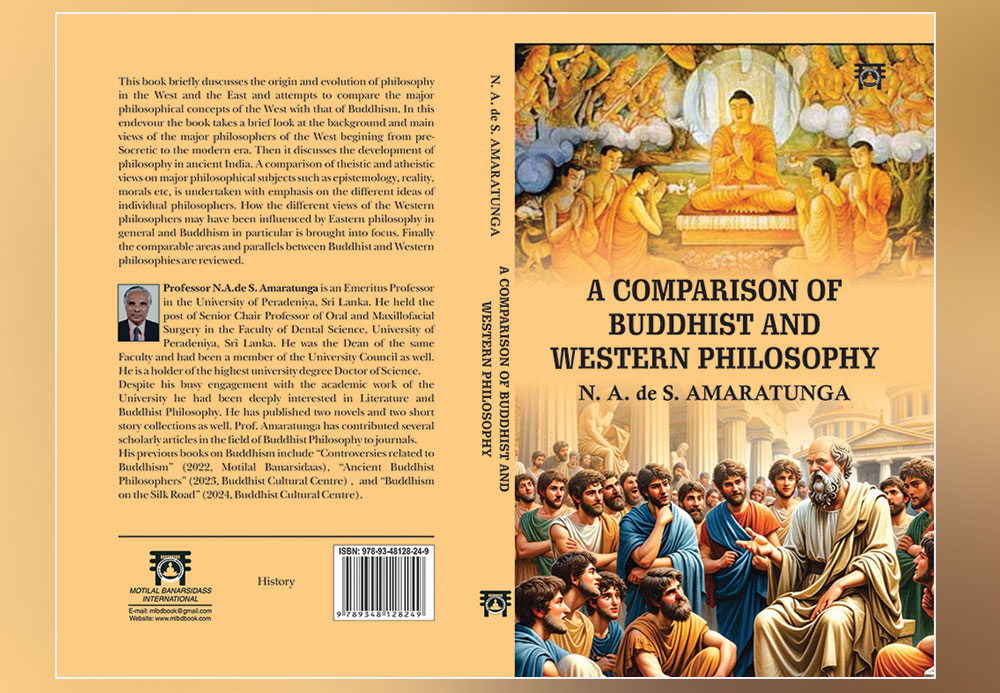
Review of Prof. N.A. de S. Amaratunga’s book:
‘A COMPARISON OF BUDDHIST AND WESTERN PHILOSOPHY’
Prof. Asoka Amaratunga is well known to the readers of The Island by his regular contributions on many topics, including Buddhism, but what is less well known is that he has authored several books on Buddhism. He seems to have well used his retirement from the Faculty of Dental Science, University of Peradeniya in 2006, as he has published four books titled; “Controversies related to Buddhism”, “Ancient Buddhist Philosophers”, “Buddhism on the Silk Road” and the latest “A Comparison of Buddhist and Western Philosophy” which is the subject of this review. A fifth titled “Maithreyanatha, Asanga, and Vasubandu – Their Life and Philosophy” is already in print.
No sooner had I started reading this valuable work than I realised what an arduous task it would have been to write, as I found great difficulty in grasping the meaning of the multitude of terms used in philosophy! Fortunately, he has taken the time and the effort to explain these terms making this book an excellent introduction to philosophy for novices, myself included. However, the scope of the work is much more significant in that it illustrates how Buddhist philosophy has heavily influenced late Western philosophy; an inference I have drawn by reading the book, though the author is less emphatic, perhaps leaving the reader to come to own conclusions based on the facts presented, which I consider a great strength of this book. It is a painstakingly crafted book which goes in to detail and, by the very nature of the subject, a difficult read but appropriate repetitions make the job of the reader easier.
Though there are similarities in the thinking of early Greek philosophers like Socrates, Plato, and Aristotle with the teachings of the Buddha, Prof Amaratunga argues against any influence and states:
“If we consider the comparable periods of the life span of these philosophers it is seen that Buddha lived from 624 – 544 BCE which is the accepted dating in Sri Lankan and South Asian tradition. On the other hand, Greek philosopher Socrates’ life span was from 470 – 399 BCE. Socrates was born more than hundred years after the death of Buddha. On the other hand, Thales of Miletus who is considered the father of philosophy lived during 624 – 546 BCE which closely match the Buddha’s life period. However, there would not have been well developed means of communication between East and West in those early times. Greece was positioned between the west and the east as it were and may have acted as a conduit for transmission of culture and knowledge in either direction but for this to happen roadways had to be built connecting these regions which may not have happened during Buddha’s and Socrates’ time. The oldest global trade route is believed to be the Silk Road which came into partial existence in the 300 BCE and was connected to the West in the 200 BCE. Active trade between the two civilisations began in 100 BCE. Cultural exchanges between the West and the East would have happened since 100 BCE”.
Though in this paragraph, commencing the final chapter of the book, Asoka mentions that the Buddha lived from 624 to 544 BCE and that Socrates was born more than hundred years after the death of the Buddha, in the preceding pages he refers to Socrates as a contemporary of the Buddha and that Buddhism started in the 5th century BCE. Perhaps, this happened because the date of birth of the Buddha is a continuing argument, some authorities opining that it is hundred years after the date accepted in our tradition. Though some speculate whether some of the ideas of Socrates were influenced by the teachings of Buddha, as there are similarities, lack of means of communication makes it unlikely. Interestingly, some experts have opined in the past that the Buddha was influenced by Socrates!
I must point out another error; in reference to Christianity he states: “Christianity began as a sect of Judaism and remained so for centuries until it perceived itself as a separate religion in the 4th Century AD. It spread widely and grew to be a world religion in the 21st Century.”
Perhaps, he meant that Christianity spread widely to be the most embraced religion and continues to do so even in the 21st century, despite dwindling numbers.
The book starts with a chapter on the influence of ancient migration on the development of philosophy, followed by several chapters on the development of Western philosophy up to modern times. He then progresses to Indian philosophy including Buddhist philosophy followed by a chapter on Epistemology. Several chapters then follow comparing Buddhist and Western philosophy dealing with the subjects of Reality, Mind and Psychology, Morals, Karma and Rebirth, Causality, God and the origin of the Universe, Evil, Freedom/Salvation, Idealism, Matter, Universe, Truth, Logic and concludes with a chapter drawing parallels between Buddhist and Western philosophies.
He refers repeatedly to similarities of William James’ views to that of Buddha but Dr Upali Abeysiri, retired Consultant Surgeon who has also written many books on Buddhism, comments:
“The Buddha also showed that the psyche is not a permanent entity but consists of a stream of units arising and ceasing. However, Western scientists attribute the first description of the momentary nature of consciousness to William James, the nineteenth century American philosopher who is considered the father of American philosophy.” (Many firsts of the Buddha; The Island, 3March 2025).
It is a shame that Westerners do not give credit to the pioneering efforts of the Buddha but books of this nature continue to highlight the fact that the Buddha’s thinking was far ahead of times and relevant even today; perhaps, for ever!
Asoka has done a great service by bringing out this analytical publication which should appeal to anyone from novices to philosophy, to those interested in Western philosophy as well as advanced aspects of Buddhist philosophy, which seems to have developed further after the Parinibbana of the Buddha, as well explained. I have educated myself and would highly recommend this book. The hard work put in to compiling this, in meticulous detail, justifies the concluding remarks:
“It is seen that there had been philosophers both in the West and in the Indian Subcontinent and in ancient times as well as modern who held contrasting as well as similar views on most of the important subjects of philosophy like epistemology, reality, mind, creation, God, morals, truth, universe, matter etc. There were and are empiricists and rationalists, realists and idealists, theists, and atheists. There were philosophers who thought origin of morals, knowledge, truth, matter, salvation etc. was God and there were others who thought the opposite. Theists attempted to justify evil as it is a creation of God according to their belief.
Buddhism based its beliefs in most of these philosophical subjects on its foundation of “anicca, dukkha, anatta”. Suffering which resulted from this natural state of the world and life formed the main focus in Buddhism. Buddha had found the cause of suffering, and the solution as discoursed in the Four Noble Truths. The path was based on a foundation of moral practice and there was no god or any other agent involved in the individual effort. Buddha and other Buddhist philosophers who followed him grounded their philosophy on Buddhist morals. Further Buddhism does not see the world as evil but the self-ego of human beings which distorts perception may create evil. Human craving is caused by this wrongful perception and craving in turn causes suffering. Several Western philosophers have been influenced by and, also, agreed with aspects of Buddhism.”
By Dr Upul Wijayawardhana
Features
Professor Herbert Allan Aponso : ‘The Great Centenarian’
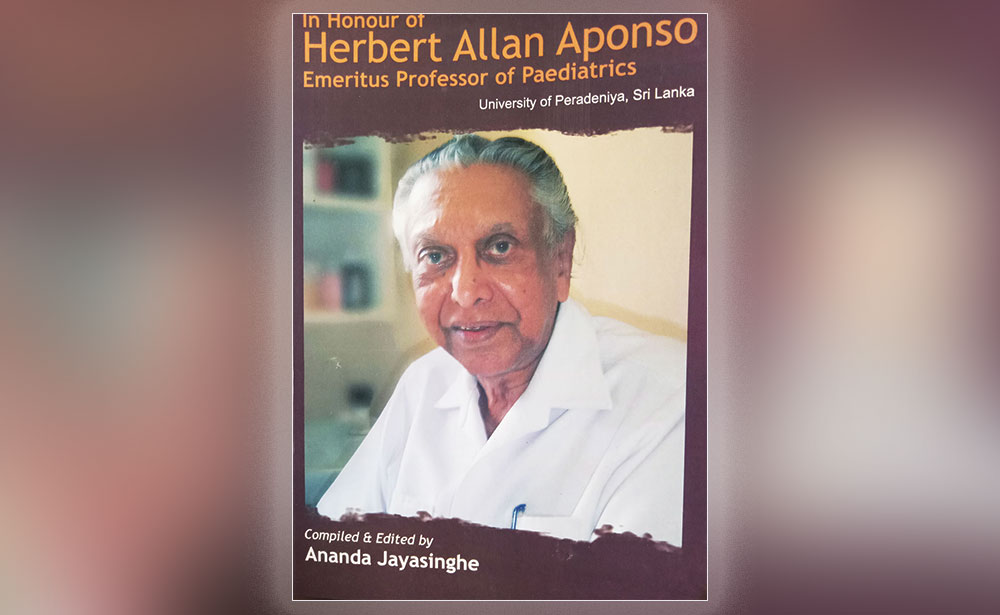
Herbert Allan Aponso, a true legend, the doyen of Paediatrics / Child Health, Professor Emeritus celebrated his 100th birthday on the 25th of March 2025, thus becoming a centenarian.
What a rare and glorious moment of anyone’s life!
I simply cannot recall any university academic achieving this exceptional milestone in Sri Lanka.
Born on the 25th of March 1925 in Lakshapathiya, Moratuwa, Professor Aponso has witnessed and thrived through a century of immense global change. It is fascinating to reflect on the world and Sri Lanka as they were in 1925. At that time, Sri Lanka (then Ceylon) was still a British colony, 23 years away from independence, with a population of just 4 million and an average life expectancy was below 40 years.
The world political map in 1925, was vastly different from that of today. One single large India without Pakistan and Bangladesh, one single Korea, no official Israel, and it was just three years after the fall of Ottoman Empire.
In the medical field, too, no United Nations, no WHO, no antibiotics, no blood banks, and no organised immunisation programmes. Diseases such as smallpox posed a dire threat to humanity, and devastating epidemics, such as the malaria outbreak in Ceylon in the early 1930s, resulted in negative population growth for the first time in history. Professor Aponso has survived through all these extreme challenging threats over the past one hundred years!
In 1964, he joined the Department of Paediatrics as a Senior Lecturer at Sri Lanka’s (then Ceylon) newly established second medical faculty, Peradeniya thus becoming a pioneer academic staff member of the Faculty of Medicine. He played a very vital role in teaching many a generation of doctors.
His brave decision to leave the position as Senior Lecturer at Faculty of Medicine, Colombo and relocate with his family to Peradeniya, is truly beyond belief as he left his birthplace and the more affluent Colombo life. At the time, the small town of Peradeniya was considered distinctly remote and less privileged.
He then became the quintessential ‘Peradeniya Man’, getting involved in the establishment of Kandy Society of Medicine (KSM), Peradeniya Medical school Alumni Association (PeMSAA) and in consolidating both the Department of Paediatrics and the Faculty of Medicine.
He retired from university service in 1993 after three decades of dedicated and remarkable service to the Faculty of Medicine and to the medical fraternity at large.
All staff members of Faculty of Medicine, Peradeniya and elsewhere who graduated before 1993 have invariably had exposure to his teaching, including myself and my wife Chandrika.
I also had the privilege of serving as Registrar in Paediatrics between 1985 and 1987 under his wing.
He is also blessed with three very caring children – Ajith, (Dr) Heshan and (Dr) Charmalie and many grandchildren and great grandchildren, all of whom care for him and look after him very well.
Professor Aponso is truly amazing and is perhaps the most complete man we can ever imagine, as he is a combination of numerous rare features moulded into one person. He has an attractive and gentle yet commanding personality, authority of a different kind, intelligence, kindness, passion, calm mind, commitment, high social standing and blessed with happy and exceptionally high-quality long life along with his gracious late wife (sadly passed away in 2017) Mrs Vimala Aponso and three caring children,
A devout Christian, Professor Aponso’s faith has been a guiding force throughout his life. At the same time, he has always recognised and respected the values of other faiths, particularly Buddhism. He often quoted the Buddhist scripture:
“Pûjâ ca pûjanîyânam” (Honour those who are worthy of honour) – Khp 5, Maṅgala Sutta.
This is well and truly appropriate and relevant to him.
He is a true legend of our time and above all a great human being.
I wish him a HAPPY 100TH BIRTHDAY!
Ananda Jayasinghe
(Retired Professor in Community Medicine, Faculty of Medicine, University of Peradeniya)
-
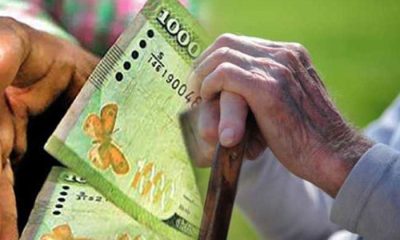
 News6 days ago
News6 days agoSeniors welcome three percent increase in deposit rates
-
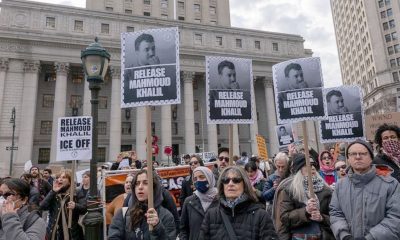
 Features6 days ago
Features6 days agoThe US, Israel, Palestine, and Mahmoud Khalil
-
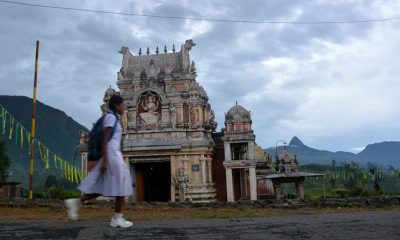
 News6 days ago
News6 days agoScholarships for children of estate workers now open
-
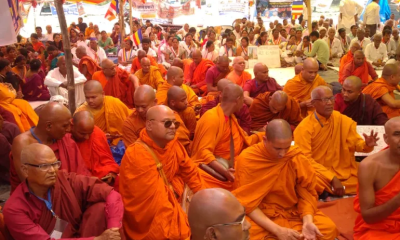
 Foreign News5 days ago
Foreign News5 days agoBuddhism’s holiest site erupts in protests over Hindu ‘control’ of shrine
-
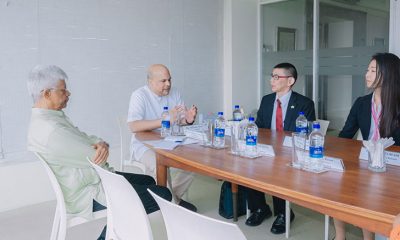
 News6 days ago
News6 days agoJapanese Defence Delegation visits Pathfinder
-
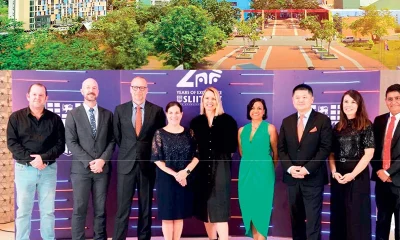
 Features3 days ago
Features3 days agoCelebrating 25 Years of Excellence: The Silver Jubilee of SLIIT – PART I
-

 Editorial5 days ago
Editorial5 days agoWhen tractors become cars!
-
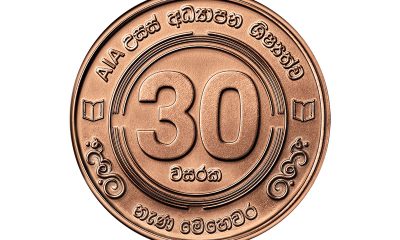
 Business1 day ago
Business1 day agoAIA Higher Education Scholarships Programme celebrating 30-year journey








